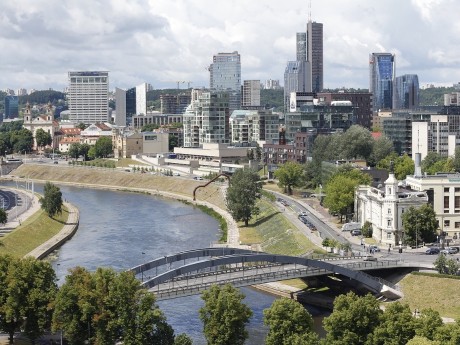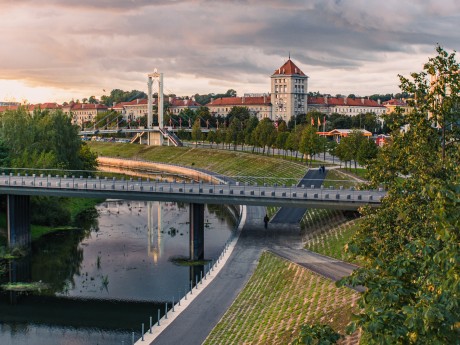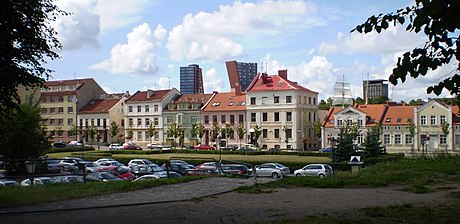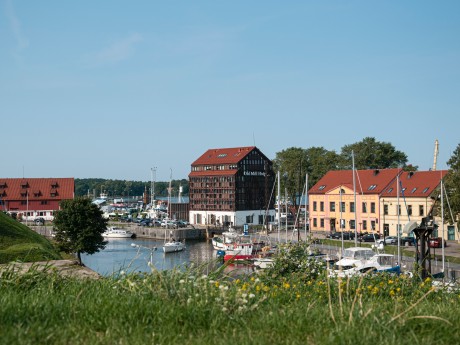Lithuania: Vilnius, Kaunas, Klaipėda
Start your exciting journey to Lithuania. Beginning in Vilnius, known for its baroque architecture, this city was made popular by its ancient history and modern culture. Walk the cobblestoned streets of the medieval Old Town, see the neoclassical Vilnius Cathedral, tour the Rumsiskes open air museum, or explore the 13th-century Higher Castle. Continue into Kaunas, the city known for its architecture, street art, museums, and historical sites.
Read more
Start your exciting journey to Lithuania. Beginning in Vilnius, known for its baroque architecture, this city was made popular by its ancient history and modern culture. Walk the cobblestoned streets of the medieval Old Town, see the neoclassical Vilnius Cathedral, tour the Rumsiskes open air museum, or explore the 13th-century Higher Castle. Continue into Kaunas, the city known for its architecture, street art, museums, and historical sites. Visit the KGB Atomic Bunker Museum, tour the Trakai Castle, explore the National M.K Ciurlionis Art Museum or walk the beautiful Juniper Valley. End your journey at the city of Klaipėda, where the Baltic Sea meets the Dane River. The port city is a popular attraction for those with interest in neoclassical Drama Theater. Start your day at the Theater Square to experience a variety of music and drama festivals. Continue to the Meridianas or go to Melnrage Beach and be sure to check out the many sculptures hidden around the city. Finally conclude your trip at the Lithuanian Sea Museum to see aquariums, dolphin shows, sea lions, and historical exhibits! Waterviews strives to offer accommodation options within walking distance of water and/or in an area of touristic interest. Our prices include taxes (but excludes local tourist taxes). Customize your trip to your personal preferences with optional activities (hit the “Add Activities’’) or change hotels, etc. Contact us for customization at no extra cost at: Service@waterviewstravel.com
Destinations
- Vilnius
- Kaunas
- Klaipėda
Itinerary
Vilnius

Vilnius (also known under its Polish and Yiddish name, Wilno and its German name, Wilna) is the capital and largest city of Lithuania. It lies on the bank of the Neris river and has approximately 560,000 inhabitants. Vilnius was the European Capital of Culture in 2009.
Read more
Vilnius (also known under its Polish and Yiddish name, Wilno and its German name, Wilna) is the capital and largest city of Lithuania. It lies on the bank of the Neris river and has approximately 560,000 inhabitants. Vilnius was the European Capital of Culture in 2009.
Additional Information
Inhabited since the Middle Ages, Vilnius has always been a multinational city with Polish, German, Jewish, Russian and Belorussian people making up a substantial share of its population. According to the last census of 2011, the population included 63.2% Lithuanians, 16.5% Poles, 12% Russians, 3.5% Belarusians, and 1.0% Ukrainians. During World War II, 80,000 Jews from Vilnius were murdered by the Nazis and their Lithuanian collaborators at the forest of Paneriai and other nearby places. After the war, most of the urban Polish population (about 65% of population) was resettled to Poland, while during 1950–1970 they were replaced by people from parts of Lithuania, neighbouring parts of Belarus, as well as Russia, Ukraine and other Soviet republics.
© Sourced from Wikivoyage
Kaunas

Kaunas is the second-largest city in Lithuania, with a population of some 288,000 people. The main reason to visit is its charming Old Town, connected to the 19th century New Town ranged along Laisvės alėja. It was the country's capital between the two world wars. The is at Rotuses Square 29, next to Town Hall. It's open M-F 09:00-20:00, Sa Su 10:00-18:00; see also the online tourist guide.
Read more
Kaunas is the second-largest city in Lithuania, with a population of some 288,000 people. The main reason to visit is its charming Old Town, connected to the 19th century New Town ranged along Laisvės alėja. It was the country's capital between the two world wars.
The is at Rotuses Square 29, next to Town Hall. It's open M-F 09:00-20:00, Sa Su 10:00-18:00; see also the online tourist guide.
Additional Information
Climate
The best time to visit Kaunas is May to August. Summers are cool - July is the warmest with an average 16°C - and there are frequent showers.
Winter is icy, bitter cold, and the days are short. Nevertheless it can be a good time to visit, because the city is well adapted to the cold. The streets get snow-plowed and the transport keeps running. Museums and similar facilities remain open. Buildings are well-heated, with cloakrooms and other storage for all your clobber. You'll need ten mins to shuck off your layers of clothing every time you enter a building, and ten mins to wrap up again before you venture out, but this is all part of the winter routine. It's companionable, everyone feels in league together against the winter, and it's as much a part of experiencing the country as church incense, vodka and potatoes. And outside you can lark about with sledges and snowmen. Choose carefully who you snowball - the locals have far greater skills than you have.
History
The city grew up in an obvious strategic position, at the confluence of the country's two main rivers. There's been settlement here for at least 2500 years but what we now call the Old Town dates from the 14th century when the castle was built. Kaunas prospered as part of the Hanseatic League into the 16th century. Medieval Lithuania had united with Poland to control a huge swathe of Europe, right down to the Black Sea, but Sweden and Russia grew and fought for regional control, and in the 17th and 18th centuries they attacked and wrecked Kaunas several times. Russia won the power struggle and took over Lithuania in 1795, while Poland was carved up between Russia, Prussia and Austria.
The Grand Army of Napoleon marched through Kaunas to occupy Moscow in 1812, and then retreated, and devastated the city both times. It had all been too easy to invade, and there were ominous local uprisings, so in the 19th century Russia tightened its grip by building up the local garrison. This culminated in the colossal military complex of "Fortress Kaunas" encircling the city; but it proved of limited value in 20th century warfare, and nowadays only the "Ninth Fort" (of ten) is standing.
Lithuania proclaimed its independence in 1918, the "First Republic". Vilnius had always been the chief city, but it was seized first by the Russian Bolsheviks then by Poland; so instead Kaunas became the provisional capital. This greatly stimulated its urban and cultural development, with handsome buildings in neoclassical, functional and Art Deco design, dubbed "Little Paris". It was a diverse city: a quarter of the population were Jewish, engaged in commercial, artisan, professional life, and religious learning.
The First Republic was crushed in 1940 when the Soviet Union annexed Lithuania. But Germany invaded the Soviet Union in June 1941 and yet again the Russians fled, choosing not to make a stand so far from Moscow. The Germans set about liquidating the Jewish population: over 30,000 perished. The Red Army retook the Baltic states in 1944, and post-war Lithuania became part of the USSR. Not until 1990 was it again independent.
© Sourced from Wikivoyage
Klaipėda

Klaipeda is Lithuania's third largest city, located in the north-western corner of the country. It is the gateway to the Curonian Spit, a stretch of sand dunes 99 km in length from 400 m to 4 km, in breadth that arcs down to the Kaliningrad region of Russia.
Read more
Klaipeda is Lithuania's third largest city, located in the north-western corner of the country. It is the gateway to the Curonian Spit, a stretch of sand dunes 99 km in length from 400 m to 4 km, in breadth that arcs down to the Kaliningrad region of Russia.
Additional Information
It was founded by Baltic tribes, and the city and castle was built by the Teutonic Order in 1252 and named Memel in honor of the river of the same name some 40 km to the south. For most of its history, Memel was part of Prussia and large battles with Lithuanian lords took place here. Invasions came from Sweden and Russia and the city was part of the Prussian Kingdom and became a prosperous harbor town. It represented the northernmost city in Germany and Prussia until 1918. After Germany lost the First World War, Memelland was first given free city status and then subsequently annexed to the newly established Republic of Lithuania. The Weimar Republic partly encouraged this annexation as it feared French influence on the League of Nation administration over the former German territory, which still bordered East Prussia, at the time a German exclave. It was briefly reabsorbed by Nazi Germany before World War II and then reverted to Lithuania (the Soviet Union) in 1945. Since Lithuanian independence in 1990, Klaipeda has become one of Lithuania's most buoyant cities with a steadily growing tourist trade.
© Sourced from Wikivoyage





